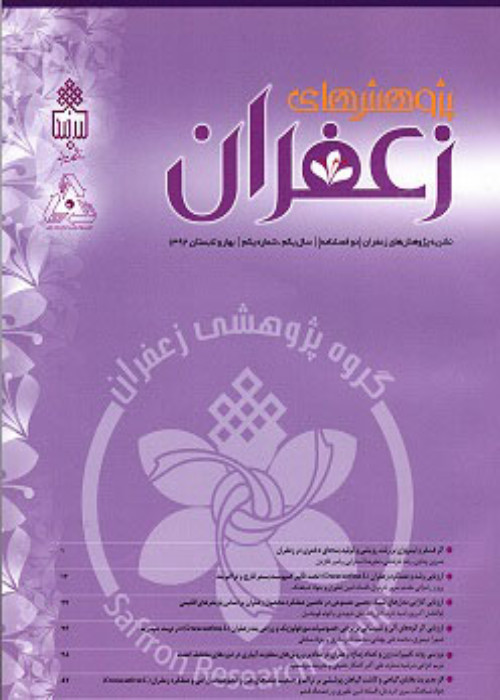Determination of Single and Dual Crop Coefficients of Saffron (Crocus sativus L.) in the First Year of Research
Author(s):
Article Type:
Research/Original Article (بدون رتبه معتبر)
Abstract:
Introduction
Water is one of the most common and at the same time the most important substance on the planet. All kinds of plants in different parts of the earth need more water than any other environmental factor. The main purpose of direct measurements or evapotranspiration calculations is the amount of water required by plants. Knowledge of the water need of plants in each region and its use in agricultural planning plays an important role in water usage. Due to the reduction of fresh water reserves in the world, accurate estimation of evaporation and transpiration and water requirement of plants seems to be important. Therefore, developing an irrigation plan and applying proper irrigation management can reduce the losses caused by water resources. The aim of the current research is to determine the evapotranspiration and plant coefficients of saffron plant and the evapotranspiration of the grass reference plant by two methods, lysimeter and FAO-Penman-Mantith, in Birjand city.Materials and Methods
The research was carried out in the agricultural year of 2018-2019 in the lysimetry laboratory of the Faculty of Agriculture, Birjand city, for this purpose. The saffron plant was grown in six lysimeters and the grass reference plant in three lysimeters, in the collection of lysimetry laboratories of the Faculty of Agriculture, Birjand University. The growth period of saffron plant was divided into four initial (27 days), development (54 days), middle (40 days) and final (54 days) stages. Irrigation was done daily until the soil moisture reached the agricultural capacity. The irrigation volume was adjusted based on the soil moisture level, the reason for which was mentioned above. The start time of irrigation was determined based on soil moisture and Fc. The end of irrigation was done according to the condition and moisture content of the soil.Results and Discussion
The average of evapotranspiration of the grass reference plant by lysimetric and FAO-Penman-Monteith methods was obtained equal to 4.32 and 4.19 mm/day, respectively, and the average of evapotranspiration of the saffron plant during the 175-day growth period was obtained equal to 2.34 mm/day. During different stages of growth, the amount of the average of single crop coefficient was estimated 0.36, 0.66, 0.86 and 0.42, respectively, and the average of dual crop coefficient was estimated 0.37, 0.67, 0.87 and 0.42, respectively. With the passage of time, the amount of evaporation-transpiration of the reference plant has increased, which can be attributed to the long day length and the increase in net solar radiation, with the increase in temperature, the amount of evaporation-transpiration also has increased, so the demand of the plant to receive water increases.Conclusion
Observations indicated that at the beginning of the period, due to high evaporation, this coefficient was clearly obtained from their sum, but in the middle stage, due to the decrease in evaporation and the predominance of transpiration, the coefficient of vegetation in most cases was Sweating has approached and this trend of changes has been the same in all lysimeters. The value of the basic vegetation coefficient (transpiration component) gradually increased after passing through the initial stage and reached the maximum value in the middle stage. The value of the evaporation coefficient from the soil surface (Ke) is the highest after the surface soil layer is wetted by rain or irrigation. As this layer dries, the evaporation coefficient will increase. In the condition that there is no water left in the surface layer of the surface soil, the evaporation coefficient reaches zero. The two-component vegetation coefficient, which is the sum of the transpiration and evaporation components, also decreases gradually. The fluctuations seen in the graph are due to the short irrigation period.Keywords:
Language:
Persian
Published:
Journal of Saffron Research, Volume:11 Issue: 1, 2023
Pages:
108 to 123
magiran.com/p2617341
دانلود و مطالعه متن این مقاله با یکی از روشهای زیر امکان پذیر است:
اشتراک شخصی
با عضویت و پرداخت آنلاین حق اشتراک یکساله به مبلغ 1,390,000ريال میتوانید 70 عنوان مطلب دانلود کنید!
اشتراک سازمانی
به کتابخانه دانشگاه یا محل کار خود پیشنهاد کنید تا اشتراک سازمانی این پایگاه را برای دسترسی نامحدود همه کاربران به متن مطالب تهیه نمایند!
توجه!
- حق عضویت دریافتی صرف حمایت از نشریات عضو و نگهداری، تکمیل و توسعه مگیران میشود.
- پرداخت حق اشتراک و دانلود مقالات اجازه بازنشر آن در سایر رسانههای چاپی و دیجیتال را به کاربر نمیدهد.
In order to view content subscription is required
Personal subscription
Subscribe magiran.com for 70 € euros via PayPal and download 70 articles during a year.
Organization subscription
Please contact us to subscribe your university or library for unlimited access!



